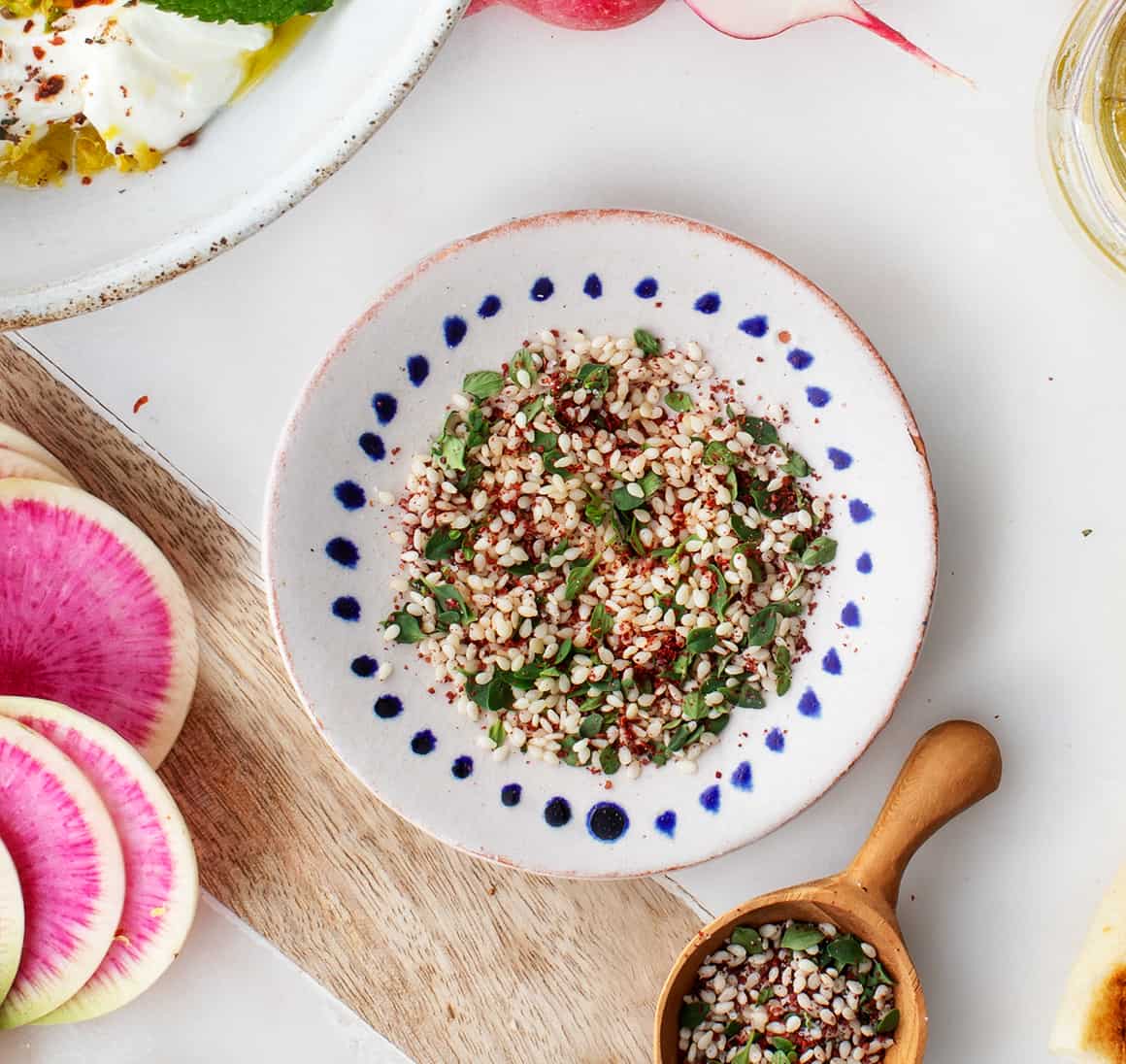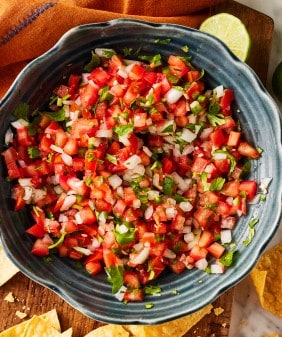If you've never tried the Middle Eastern spice blend za'atar, get ready to fall in love. Tangy, nutty, and herby, it's delicious on breads, dips, and more.

Have you ever tried za’atar? The word actually refers to two things: an herb related to thyme and oregano and a Middle Eastern spice blend. Here, we’ll be focusing on the spice. It’s herby, nutty, tangy, and salty, and it’s a seasoning that you absolutely want to be cooking with.
Though you can find za’atar seasoning at Middle Eastern grocery stores and spice shops, it’s still not widely available in the US. If you can get your hands on a good store bought blend, I encourage you to try it, but you should also make your own. That way, you’ll know all the components are fresh and potent, and you can customize it, choosing the ingredients and the ratios that you like best.
This recipe is my ideal za’atar spice mixture – it has lots of sesame and incorporates fresh herbs in addition to dried spices. I hope you love it as much as I do, but there’s no single right way to make za’atar. If you like yours a little tangier or a little saltier, taste and adjust to create a blend you love.
Za’atar Recipe Ingredients
No two za’atar recipes are the same – the exact ingredients and ratios vary throughout the Middle East and the world. Often, it includes toasted sesame seeds, ground sumac, salt, and dried herbs such as dried oregano, marjoram, thyme, and…za’atar! I keep my recipe simple with these 5 ingredients:
- Fresh thyme – While za’atar is traditionally made with dried herbs, I love the unique flavor of the fresh thyme here. If you don’t have any on hand, or if you want your spice blend to keep for longer, feel free to use dried thyme in its place.
- Sesame seeds – They add a slight crunch and a wonderful nuttiness. For a richer flavor, toast your sesame seeds before making za’atar.
- Sumac – If you’ve never tasted this bright red spice before, you’re in for a treat. Popular in Middle Eastern and Mediterranean cooking, sumac has a tart, lemony flavor that gives this za’atar a delicious sour kick. If you can’t find sumac at your grocery store, look for it in a Middle Eastern market, a spice store, or online.
- Sea salt – To make the fresh, nutty, and tart flavors pop!
- Ground cumin – It’s not a traditional za’atar ingredient, but it adds a little extra complexity to this recipe. If you don’t have any on hand, feel free to skip it! The spice blend tastes great with or without it.
Just mix it all together, and enjoy! If you’d like your spice mix finer, crush everything in a mortar and pestle. Made with fresh thyme, it will keep in an airtight container in the fridge for up to 5 days. If you use dried thyme, it will keep at room temperature for up to 1 month.
Find the complete recipe with measurements below.

Za’atar Spice Serving Suggestions
Once you have za’atar on hand, you’ll discover a thousand ways to use it! Throughout the Middle East, it’s commonly dusted over labneh, baked onto flatbreads called man’oushe, and sprinkled over meats and vegetables. Here are a few more ideas to get you started:
- Stir it into olive oil to make a dip for pita or crusty bread. I love to serve this combination for an easy, flavorful appetizer!
- Sprinkle it over hummus, baba ganoush, or white bean dip topped with a drizzle of olive oil. Don’t forget the fresh veggies or pita for dipping!
- Toss it with roasted vegetables like potatoes, fennel, or cauliflower.
- Use it to dress up grilled vegetable kebabs or grilled zucchini.
- Sprinkle it over homemade focaccia before it goes in the oven.
- Toss it with quinoa, couscous, or rice and olive oil for an easy side dish.
- Sprinkle it over sliced tomatoes or cucumber for a fresh side dish or snack.
- Dust it onto avocado toast.
- Use it to punch up simple hard boiled eggs.
- Toss it with crispy roasted chickpeas for a healthy snack.
How do you like to use za’atar? Let me know in the comments!

More Favorite Middle Eastern and Mediterranean-Inspired Recipes
If you love this za’atar seasoning, try one of these recipes next:

Za'atar
Ingredients
- 2 tablespoons chopped fresh thyme or 2 teaspoons dried
- 2 tablespoons sesame seeds
- 2 teaspoons ground sumac
- 1/2 teaspoon sea salt
- 1/4 teaspoon ground cumin, optional
Instructions
- In a small bowl, mix the thyme, sesame seeds, sumac, and sea salt. Alternatively, you can grind everything in a mortar and pestle for a finer spice.
- Sprinkle onto labneh, hummus, baba ganoush, avocado toast, or follow any of the serving suggestions listed above.















Do you have an idea what I could use instead of sesame seeds in making a mock za’atar? We loved the taste, but have a family member who has a dangerous anaphylactic response to sesame seeds. She’s not, fortunately, allergic to peanuts, pecans, walnuts etc, but not sure what to use instead. Thank you!
Thanks a lot for sharing such posts.
Hi Jeanine! Just stumbled on your website and your content is beautiful!
Keep up the great work.
P.s. I’ll have to try this sometime once I get hold of sumac.
thanks Anna!
What is sumac? Flavor profile ?
Hi Diane, it has a tart lemony flavor.
It must be za’atar season because we’ve been making za’atar chicken non-stop! We’ve put the chicken in homemade deep dish pizzas and made tacos with the chicken skin adding some harissa and Haitian pikiz (spicy coleslaw). We’ve been using a paste found at WF and added extra seasonings but we’ll have to try yours as well 🙂
Hi Miriam, that sounds delish!